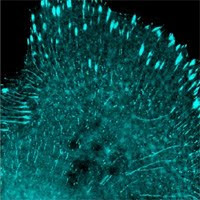NF-kB (nuclear factor kappa-light-chain-enhancer of activated B cells) refers to a protein complex functional in signaling pathways, particularly in response to stress stimuli. There are two signaling pathways leading to the activation of NF-kB signaling, known as the canonical (or classical) pathway, the non-canonical (or alternative) pathway. (from AlleleBlog)
In the canonical NF-kB pathway, NF-kB dimers such as p50/RelA are maintained in the cytoplasm by interaction with an independent Inhibitor of NF-kB (IkB) molecule. When the upstream signaling is active, an IkBa kinase (IKK) complex consisting of catalytic kinase subunits IKKa and/or IKKb and the scaffold protein NEMO will be recruited to the cytoplasmic adaptor of certain cell surface receptor and stay activated. Activation of IKK complex will consequently phosphorylate the IkB at two serine residues, which induce the proteasomal degradation of IkB. Released from IkB, NF-kB dimers then translocate into the nucleus and bind with a consensus sequence (GGGACTTTCC) of various genes and thereby activates their transcription. In a negative feedback loop, NF-kB activation also leads to the expression of the IkB gene, which subsequently sequesters NF-kB subunits and terminates transcriptional activity unless a constitutive activation signal is present.
The non-canonical pathway is mainly for activation of p100/RelB complexes during B-and T-cell development, where NF-kB was first discovered. Different from the canonical pathway, 1) only certain receptor signals (e.g., Lymphotoxin B, B-cell activating factor, CD40) can activate this pathway, 2) it proceeds through an IKK complex that contains two IKKa subunits (but not NEMO) and 3) receptor binding leads to activation of the NF-kB-inducing kinase NIK, which phosphorylates and activates an IKKa complex, the latter in turn phosphorylates two serine residues adjacent to the ankyrin repeat C-terminal IkB domain of p100, leading to its partial proteolysis and liberation of the p52/RelB complex.
Other distinct NF-kB pathways undoubtedly exist. For example, p50 (or p52) homodimers enter the nucleus, where they become transcriptional activators by virtue of interaction with the IkB-like co-activator Bcl-3 (or IkBz). How these are regulated is not known.
There are many ways of applying reagents that can manipulate the NF-kB system for drug screening as well as basic research. For this reason, Allele Biotech is introducing a set of lentiviruses as listed below. The way this product group is operated is that the Allele will publish the design and specifics of the products, but will produce it upon the first order. The person who places the first order will need to wait for 3-5 weeks for receiving the products, but will receive a 40% discount and an opportunity to provide input to the product design. The platform for lentiviral products is based on our field-leading high titer lentivirus packaging capabilities, and you can rest assured that high quality lentivirus will be produced at a pace much faster and lower price than if you were to make them by your own lab or find them from anywhere else. Allele Biotech will introduce more such products in the fields of miRNA (to provide all ~800 human miRNA and their anti-miRNA silencers on virus), cell differentiation lineage-specific promoter-FP reporters, etc. We now call these products the Lead Products. Cost effectiveness is just the beginning. Imagine how our ingenuity and innovation can pave the way for your research.
1) HiTiter IkBa Expression Lentiviral Particles: can be used in functional studies of IkBa’s roles in NF-kB signaling. Overexpression of IkBa will eliminate the low-level activation by factors in the cell culture medium or other fluctuations to ensure that any change in NF-kB signaling is caused by the stimulus being tested.
2) HiTiter Dominant Negative IkBa Expression Lentiviral Particles: Dominant Negative IkBa has serine-to-alanine changes at residues 32 and 36. It can be used to repress the expression of endogenous IkBa or block NFkB signaling in certain cell lines.
3) HiTiter IkBa-RFP Fusion Expression Lentiviral Particles: This is a reporter suitable for the studying proteasomal degradation of IkBa after phosphorylation.
4) HiTiter IKKa Expression Lentiviral Particles: can be used in functional research for the role of IKKa in NF-kB signaling.
5) HiTiter Constitutively Active IKKa Expression Lentiviral Particles: Constitutively active IKKa has serine-to-glutamate mutations at residues 176 and 180.
6) HiTiter Dominant Negative IKKa Expression Lentiviral Particles: Dominant negative IKKa is mutated by serine-to-alanine at residues 176 and 180.
7) HiTiter IKKb Expression Lentiviral Particles: can be used in functional research for the role of IKKb in NF-kB signaling.
8) HiTiter Constitutively Active IKKb Expression Lentiviral Particles: Dominant negative IKKb is mutated by serine-to-glutamate at residues 177 and 181.
9) HiTiter Dominant Negative IKKb Expression Lentiviral Particles: Dominant negative IKKb is mutated by serine-to-alanine at residues 177 and 181.
10) HiTiter pNFkB-Luciferase Lentiviral Particles: a cis-reporter plasmid containing the luciferase reporter cDNA linked to five repeats of an NF-kB binding site.
11) HiTiter pNFkB-GFP Lentiviral Particles: a cis-reporter plasmid containing the GFP reporter gene linked to five repeats of an NF-kB binding site.
New Product of the Week 05-23-10 to 05-31-10:
Cre recombinase fused to mWasabi GFP carried on lentivirus, ABP-RP-Cre2AGL, or ABP-RP-Cre2AGS
Promotion of the week 05-23-10 to 05-31-10:
actually 3 promotions this week, first announced to Allele fans and friends on Facebook: 10% off the brand-new RFP-Trap ACT-CM-RFA0050 for co-IP with mCherry, mPlum, mOrange…Order by Monday to qualify for discount! Free sample for FAM-amidite for oligo cores at universities that make qPCR and other probes. Free sample of high attachment tissue culture plates that use 40% less plastics (made in Canada)
Saturday, May 29, 2010
Lentiviruses expressing constitutively active or dominant negative versions of genes in signaling pathways
Labels:
Bcl-3,
drug screening,
IkBa,
IkBz,
Ikka,
Ikkb,
lentivirus,
NEMO,
NF-kB,
p100,
p50/RelA,
p52/RelB,
signaling pathways,
stimuli,
stimulus
Subscribe to:
Post Comments (Atom)




No comments:
Post a Comment